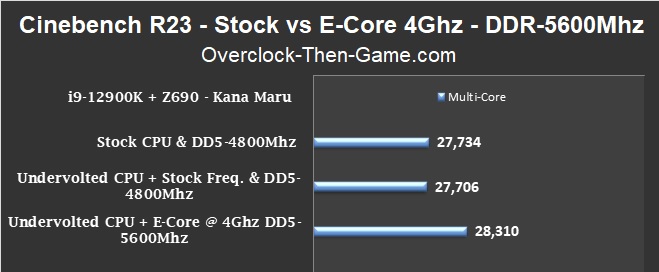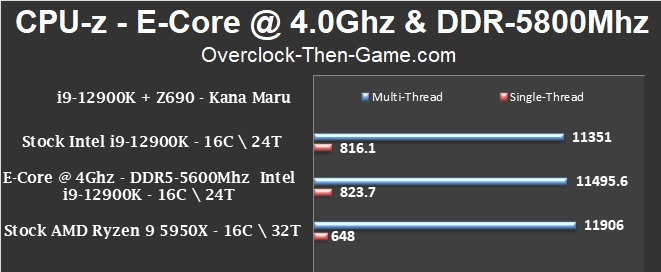DDR5 OverclockingSynthetic Benchmarks
Cinebench R23 - DDR5-5600Mhz

The stock CPU settings with DDR5-4800Mhz and the undervolted CPU with DDR5-4800Mhz shows that the results are within the margin of error (0.1%), so those result are fine. When I overclock the E-Cores to 4GHz and the DRAM to 5600Mhz I increased my score by 576 points.
7-Zip 19.00v - DDR5-5600Mhz

Similar to all of my previous benchmarks I have shown the stock settings vs the undervolted (1.11v) settings. The Compression test shows a 13% increase, the Decompression test shows a 4% increase and the Total Rating shows a 8% increase.
y-cruncher - DDR5-5600Mhz

I have decided to show all of my benchmark results so that everyone can see the performance scaling. There are 4 results for y-cruncher and they actually grouped into two pairs. The first pair shows the stock settings against the undervolted settings & E-Cores overclocked to 4GHz. Both of the first two benchmarks are running DDR5-4800Mhz. The second pair shows nearly the same settings above, but with the DDR5-5600Mhz frequency and CPU undervolted even further to 1.11v. Overclocking the E-Cores to 4GHz along with the DDR5-5600Mhz shows that the benchmark completes 2.02 seconds quicker over the stock settings (1.26v + DDR5-4800Mhz). That is roughly an 8 percent gain in performance while dropping the total system wattage by 93 watts.
CPU-z - DDR5-5600Mhz

CPU-Z shows a slight increase as well which is fine since I am using much less voltage while increasing the overall performance. My multi-thread score increased by 145 points and the single-thread score increase by 8 points. CPU-Z includes CPU references and I decided to use the AMD Ryzen 5950X (16C \ 32T) as a comparison.